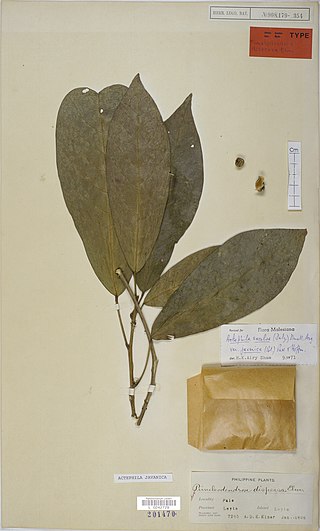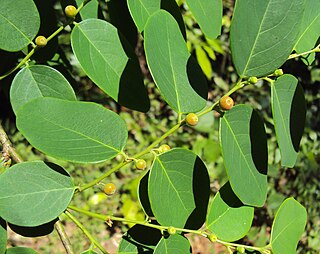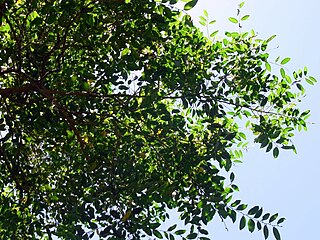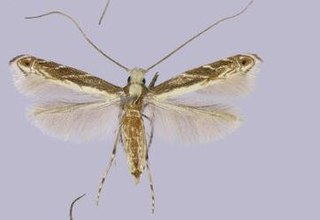
Phyllanthus is the largest genus in the plant family Phyllanthaceae. Estimates of the number of species in this genus vary widely, from 750 to 1200. Phyllanthus has a remarkable diversity of growth forms including annual and perennial herbs, shrubs, climbers, floating aquatics, and pachycaulous succulents. Some have flattened leaflike stems called cladodes. It has a wide variety of floral morphologies and chromosome numbers and has one of the widest range of pollen types of any seed plant genus.

Phyllanthaceae is a family of flowering plants in the eudicot order Malpighiales. It is most closely related to the family Picrodendraceae.

Bischofia is a genus of plants in the family Phyllanthaceae first described as a genus in 1827. It is native to southern China, the Indian Subcontinent, Queensland, New Guinea, and various islands of the Pacific. It is the only member of the tribe Bischofieae. They are dioecious, with male and female flowers on separate plants, but may rarely be monoecious.

Breynia is a plant genus in the family Phyllanthaceae, first described in 1776. It is native to Southeast Asia, China, the Indian Subcontinent, Papuasia, Australia, and the island of Réunion.

Actephila is a genus of plants in the family Phyllanthaceae, first described as a genus in 1826. It is one of 8 genera in the tribe Poranthereae, and is most closely related to Leptopus. The name of the genus is derived from two Greek words, akte, "the seashore", and philos, "loving". It refers to a coastal habitat.

Richeria grandis is a tree species in the family Phyllanthaceae which ranges from the Lesser Antilles to South America. The species is reputed to have aphrodisiac properties.
Glochidion rapaense, also known by its synonym Phyllanthus rapaense, is a species of tree in the family Phyllanthaceae. It is endemic to the island of Rapa in the Austral Islands of French Polynesia. Molecular phylogenetic analysis indicates that it is extremely closely related to Glochidion longfieldiae, which is also endemic to Rapa.
Glochidion temehaniense, also known by the synonym Phyllanthus temehaniensis, is a species of tree in the family Phyllanthaceae. It is endemic to the Society Islands of French Polynesia, where it is native to the islands of Tahaa, Raiatea, and Huahine. Like all other species of Glochidion, it is pollinated by leafflower moths in the genus Epicephala.

Breynia oblongifolia, commonly known as coffee bush, grows naturally in Australia and New Guinea as shrubs up to 3 m (10 ft) in height. The species produces alternate, distichous, ovate leaves 20–30 mm (0.8–1.2 in) long by 10–20 mm (0.4–0.8 in) wide. Small, green flowers are produced in spring and summer, and these are followed by orange or pink berries about 6 mm (0.24 in) diameter that turn black when fully ripe.

Glochidion ferdinandi, with common names that include cheese tree, is a species of small to medium–sized trees, constituting part of the plant family Phyllanthaceae. They grow naturally across eastern Australia, from south–eastern New South Wales northwards to northern and inland Queensland, in rainforests and humid eucalypt forests. Frugivorous birds such as pigeons, figbirds and parrots consume its fruit.

Epicephala is a genus of moths in the family Gracillariidae.

Breynia vitis-idaea, the officinal breynia, is a perennial tree-like species of Phyllanthaceae, found from India east to Taiwan and Okinawa and south to Indonesia. It is a shrub or treelet with egg-shaped leaves that can reach up to 3 m tall. It has staminate flowers and spherical, red fruit.

Glochidion sumatranum known as the umbrella cheese tree is a plant in the family Phyllanthaceae. Although recognized as a distinct species by some sources, others include it within Glochidion zeylanicum. It is found in northern and eastern Australia, New Guinea and Indonesia. The habitat is rainforest, or rainforest margins in swampy areas, sometimes associated with palms. It may grow to 15 metres tall. The most southerly point of natural distribution is Iluka, New South Wales.

Epicephala vitisidaea is a moth of the family Gracillariidae. It is found in Fujian, China and on the Ryukyu Archipelago.
Epicephala lanceolaria is a leafflower moth of the family Gracillariidae. The only known host of the larva is Glochidion lanceolarium which is pollinated by the imago.

Breynia disticha is a plant in the family Phyllanthaceae, first described in 1776. It is native to New Caledonia and Vanuatu in the western Pacific, but naturalized on a wide assortment of other islands around the world, as well as in the U.S. state of Florida.

Breynia cernua grows naturally in Australia and Malesia as a shrub up to 2 m (7 ft) in height.

Glochidion puberum is a species of shrub or small tree in the family Phyllanthaceae. It is native to China, where it is widely distributed in both subtropical and temperate regions. It has also been reported from Taiwan and Japan, and is morphologically very similar to the species Glochidion chodoense, endemic to southern South Korea. In Mandarin it is known as 算盘子 (suanpanzi), which also refers to the genus Glochidion as a whole. In China it is used for medicinal purposes.
Glochidion lanceolarium is a species of leafflower tree in the family Phyllanthaceae. It is native to Cambodia, China, India, Laos, Thailand, and Vietnam. In Mandarin it is known as 艾胶算盘子.

Phyllanthus reticulatus is a plant species described Jean Louis Marie Poiret; it is included in the family Phyllanthaceae.















